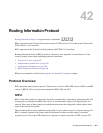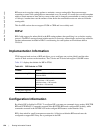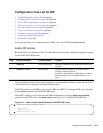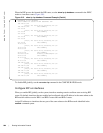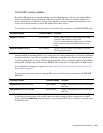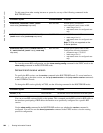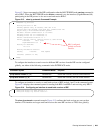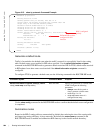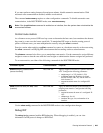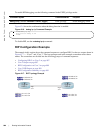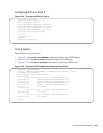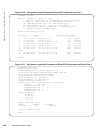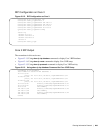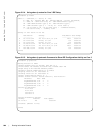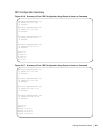
Routing Information Protocol | 885
If you must perform routing between discontiguous subnets, disable automatic summarization. With
automatic route summarization disabled, subnets are advertised.
The command
autosummary requires no other configuration commands. To disable automatic route
summarization, in the ROUTER RIP mode, enter
no autosummary.
Control route metrics
As a distance-vector protocol, RIP uses hop counts to determine the best route, but sometimes the shortest
hop count is a route over the lowest-speed link. To manipulate RIP routes so that the routing protocol
prefers a different route, you must manipulate the route by using the
offset command.
Exercise caution when applying an
offset command to routers on a broadcast network, as the router using
the
offset command is modifying RIP advertisements before sending out those advertisements.
The
distance command also allows you to manipulate route metrics. Use the command to assign different
weights to routes so that the ones with the lower weight or administrative distance assigned are preferred.
To set route metrics, use either of the following commands in the ROUTER RIP mode:
Use the
show config command in the ROUTER RIP mode to view configuration changes.
Debug RIP
The debug ip rip command enables RIP debugging. When debugging is enabled, you can view
information on RIP protocol changes or RIP routes.
Note: If the ip split-horizon command is enabled on an interface, then the system does not advertise the
summarized address.
Command Syntax Command Mode Purpose
distance weight [ip-address mask
[access-list-name]]
ROUTER RIP Apply a weight to all routes or a specific route and
ACL. Configure the following parameters:
• weight range: 1 to 255 (default is 120)
• ip-address mask: the IP address in dotted
decimal format (A.B.C.D), and the mask in
slash format (/x).
• access-list-name: name of a configured IP
ACL.
offset access-list-name {in | out} offset
[interface]
ROUTER RIP Apply an additional number to the incoming or
outgoing route metrics. Configure the following
parameters:
• access-list-name: the name of a configured IP
ACL
• offset range: 0 to 16.
• interface: the type, slot, and number of an
interface.



